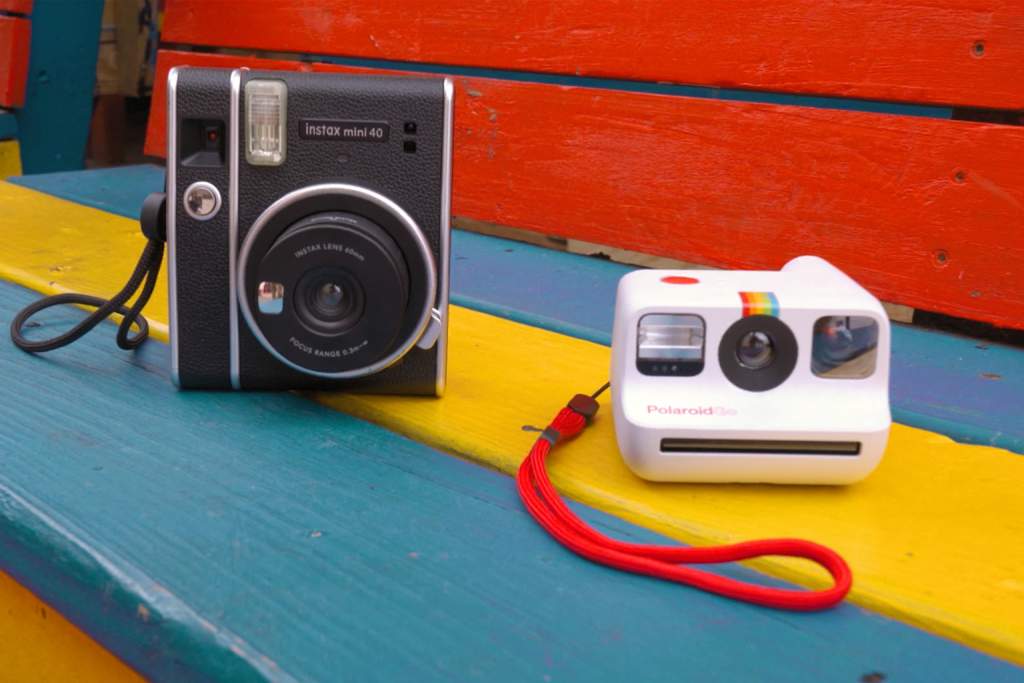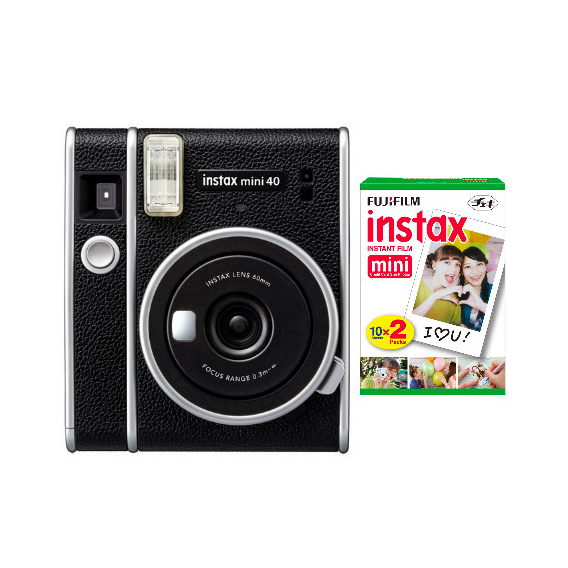The Instax Mini 40 and Polaroid Go were both released in April of this year. If you’re in the market for a portable instant camera, either model is a great choice. However, if you’re not sure which camera is right for you, we recently compared the Instax Mini 40 vs Polaroid Go in a hands-on test.
Shooting in the vibrant Brooklyn neighborhood of Bushwick, we set out to compare the build, usability, and image & film quality offered by each camera.
Build

While Instax has been releasing Mini instant cameras since 1998, the Go is Polaroid’s first attempt at an ultra-compact build, and it does not disappoint. The Polaroid Go measures 5.9 x 3.3. x 2.4 inches, and weighs 8.48 oz, while the Instax Mini 40 measures 4.1 x 4.8 x 2.6 inches, and weighs 11.64 oz.
While it may be hard to tell from the specs, there is a significant difference in size between the two cameras. You won’t have trouble fitting either one in a tote or handbag, but the Polaroid Go will certainly take up less space. You could probably even fit it in a large jacket pocket.
Other than size and weight, both cameras offer pleasing, yet distinct retro builds. The square-shaped Instax Mini 40 has a textured, faux-leather casing with silver accents and a metal logo plate on the front. There’s also a selfie mirror next to the lens and a silver shutter button below the viewfinder.
A button at the base of the Mini 40’s lens extends the lens and turns the camera on. Film is loaded through a slot on the back, and there’s also a manual exposure counter. The camera uses two AA batteries, with a battery life of approximately 10 Instax Mini film packs (10 exposures per pack).
Meanwhile, the Polaroid Go has a smaller, rounded shape, reminiscent of a vintage View-Master stereoscopic toy. The camera has white polycarbonate and plastic housing, with a rainbow strip and large, red shutter button on top. There’s also a button to turn the flash on or off.
On the front of the camera, the lens is centered between the flash and the viewfinder, which also doubles as a selfie mirror. On the back, there’s a power button and an LED screen that displays the number of remaining exposures. The Polaroid Go has a built-in rechargeable battery and comes with a USB charging cable. Battery life is approximately 15 Polaroid Go film packs (16 exposures per pack).
Usability

Both cameras employ a simple, minimalist design that makes them incredibly easy to use.
The Instax Mini 40 is a true point and shoot instant camera. In a comparison with the Instax Mini 11, we found the Mini 40 was effectively the same camera housed in a new, retro build. The camera has automatic exposure control, so all you need to do is frame up and hit the shutter. Unfortunately, there is no way to turn the flash off like on the Polaroid Go, although the Instax Mini film is generally quite versatile.
The Mini 40 has just two buttons: the shutter, and the power button that automatically extends the lens. After taking a shot, the photo is ejected from the top of the camera within seconds.
Selfie Mode is as advanced as the Mini 40 gets, and even that is straight forward. Before taking your photo, simply pull the front element of the lens until you see the words ‘SELFIE ON’ on the barrel. You should use Selfie Mode when shooting a subject that is 1ft – 1ft 8 inches away.
The Polaroid Go is similarly easy to use, with only three buttons: the shutter, flash button, and a power button. However, it also offers cool features including a self-timer and double exposure function.
The flash button allows you to turn the flash on or off, but holding it down for two seconds activates the self-timer. After activating the self-timer, place the camera in position, hit the shutter, and get in position. You’ll have nine seconds before the photo is taken.
A double exposure involves exposing the same film print twice, resulting in cool image overlay effect. Simply press the flash button twice in rapid succession. The number of exposures displaying on the LED display will change to a flashing “1”. You can now shoot the first exposure. After hitting the shutter, the film will remain in the camera and the flashing number will change to a “2”. Press the shutter again to take the second exposure.
Polaroid recommends shooting a portrait lit from behind without flash for the first shot of your double exposure. Then, for the second photo, shoot a pattern or texture. If you want the subject of your second shot to stand out, try to frame them in the same position as the darkest area of your first exposure.
After taking a photo, the Polaroid Go ejects the image from the front moments later. The camera has a frog tongue that holds the ejected photo, protecting it from additional exposure while it’s still developing.
Image & Film Quality
Image and film quality is one of the most crucial differences when it comes to the Instax Mini 40 vs Polaroid Go.
The Mini 40 uses Instax Mini film, which is available in a variety of styles such as Black, Rainbow, and Pink Lemonade. A pack contains 10 exposures, with each exposure taking just 90 seconds to develop. The ISO 800 film measures 3.4 x 2.1 inches, with an actual picture size of 2.4 x 1.8 inches.
The Polaroid Go uses Polaroid Go film, and there is currently only one style available. A pack contains 16 exposures, each measuring 2.6 x 2.1 inches with an actual picture size of 1.9 x 1.8 inches. Polaroid reports the ISO 640 film will develop in 10-15 minutes, though we found some of our photos needed up to 25 minutes to fully develop.
Despite its shorter developing time, we found the Mini 40 photos were generally sharper, more realistic, and had better color rendition than the photos we captured on the Polaroid Go. The Go photos had a warm, magenta hue, and were certainly consistent with the style offered by Polaroid’s instant cameras over the last seventy years. However, the Go film was also more sensitive, and we experienced some issues with washed out colors on several photos. Mini 40 photos of the same subject, captured at the same time, turned out fine.
Price
The Instax Mini 40 currently costs $99.95, or $119.95 with a twin pack of the standard Mini film. Separately, Mini film packs range in price from $14.95 to $29.95.
The Polaroid Go costs $109.99, or $119.95 with a double pack of Go film. A double pack of Go film goes for $29.95 when sold separately.
The Verdict
There is no clear winner in a comparison of the Instax Mini 40 vs Polaroid Go. Both cameras are worthwhile investments, depending on what you’re looking for.
For a smaller build, cool bonus features, and photos with a nostalgic charm, the Polaroid Go is the logical choice. If you’re more interested in capturing better quality, more realistic photos, we recommend the Instax Mini 40. Regardless of the model you choose, you’re sure to instantly fall in love.













